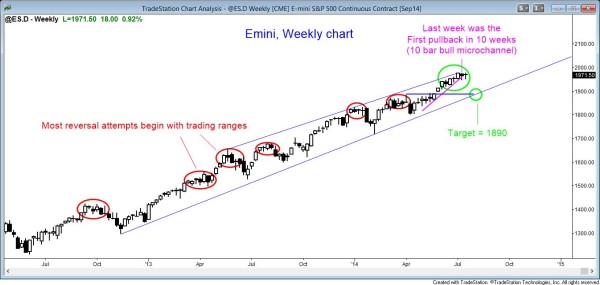
The weekly Emini candle chart shows the market testing the top of the bull channel, setting up either a bull breakout or, more likely, a failed bull breakout of the trend channel.
The most important price action in the weekly market update is the attempt to breakout of the trend channel. Most attempts to break out above or below both bull and bear channels fail. A failed channel breakout is usually followed by a reversal and then a test of the opposite side of the channel.
Last week’s low fell below the low of the week before. That was the first pullback in 10 weeks, which makes it the first bear breakout below a bull microchannel. There are usually buyers of that first bear breakout, and the market usually goes up for another one to three bars (weeks, since this is a weekly chart) before it reverses again. When it does, the reversal usually falls for a couple of legs. My initial objective is at least ten bars and two legs sideways to down. Since this is a weekly chart, the pullback might last a couple of months.When a bull microchannel occurs early in a bull trend, it is usually a breakout and is followed by at least a couple of big legs up (a trend). When it occurs late in a trend, like it is here, it is more likely a buy climax and usually is followed by a couple of small legs down (a pullback).
The obvious downside support is the bottom of the channel, which right now is just below 1900. Another reason for the selloff, if it comes, is that it would be a test of the breakout above the top of the May trading range, which is around 1890. The selling does not have to stop there, but those are the first targets where bears will take partial or full profits and bulls will begin to buy again.
Strong trends usually have to transition into trading ranges before pulling back. In fact, most reversal patterns involve trading ranges (see red circles). For example, a major trend reversal and a head and shoulders top are both trading ranges. Most trend reversal attempts either fail or do not go far, but they usually offer at least a trading opportunity. The three sideways bars in the green circle (some traders would call it seven bars) might be another attempt, especially since the market is at the top of a channel and because the market had a bear breakout of a bull microchannel.
Traders can see the end of the day bar-by-bar price action report by signing up for free at BrooksPriceAction.com. I talk about the detailed Emini price action real-time throughout the day in the BrooksPriceAction.com trading room, and a 2 day free trial is available.
Background information on this report can be read on the Intraday Market Update page.

